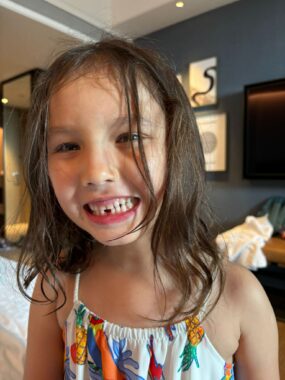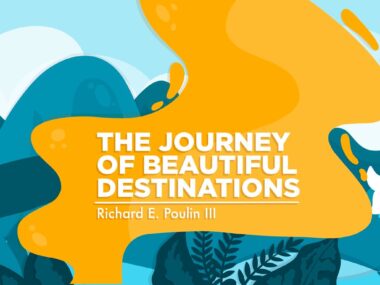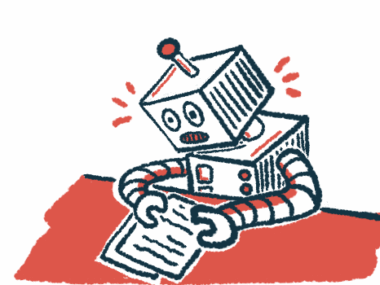The first missing tooth is a time to celebrate years of work
A joyous milestone achieved after sensitivity to symptoms of AADC deficiency
Written by |

A few weeks ago, our daughter, Rylae-Ann, mentioned she had a wiggly tooth. I gently pushed her teeth and found the wiggly one. The moment of losing her first tooth was near, and my wife, Judy, and I decided to use it as a learning moment.
When Rylae-Ann was born, we learned she had a rare disease called aromatic l-amino acid decarboxylase (AADC) deficiency. All newborns are dependent on their parents, but with AADC deficiency, they’re even more so.
Rylae-Ann stopped meeting her milestones when she was about 3 months old. She had low muscle tone, known as hypotonia. She wasn’t able to hold her head upright, and swallowing was a struggle.
Judy and I cared for her as best we could, but there was a lot of trial and error as we embarked on this new journey. One typically simple daily routine was brushing her teeth.

Rylae-Ann uses a toothbrush independently at age 3. (Photo by Richard E. Poulin III)
Obviously, we had to do this for her, as we would with any newborn, but the sensation and sounds of brushing triggered crying. We tried to go very slow, but we didn’t want tears to stop her from having good oral health. Singing songs, making the toothbrush come alive, and taking the task in small increments allowed her to become accustomed to brushing her teeth.
I continued brushing her teeth until she was about 3 years old. Fortunately, she had gene therapy, and over time, she gained enough fine motor skills to hold her toothbrush and complete the necessary brushing strokes.
To help her learn, I transitioned from being the brusher to letting her hold the toothbrush while I guided her hands. Eventually, she gained independence when brushing her teeth and continues to enjoy doing it after her bath. I still do a final brush to ensure she gets all the nooks and crannies.
Over the years, she’s accepted the sensation of brushing her teeth and no longer fears the task. That was fortunate because the day finally came when she noticed her tooth was wiggling.
Losing the first tooth
We never talked about how her baby teeth would fall out and new ones would grow, so she was alarmed when she noticed a loose tooth.
Judy and I began by reading books about the tooth fairy and finding educational books about teeth with many pictures. In addition to preparing for her tooth to come out, she learned many facts and vocabulary words.
As the days passed, she gave us updates on her wiggly tooth. At the start of July, we had to return to Taiwan so Rylae-Ann could complete her annual checkup for a long-term study on the effectiveness of gene therapy. At this point, the first tooth loss was imminent.
When it became very wiggly, Rylae-Ann asked me to help her pull it out. I wanted her to do it, as it seemed like a rite of passage. Also, I didn’t want it to be an unpleasant experience she’d remember when the others began falling out.
I was a bit worried Rylae-Ann would swallow her tooth, but we kept an eye on it. While waiting in a hotel lobby, Rylae-Ann casually tested her tooth. Judy was at the counter checking us in while I attended to my phone. Once the key card was in hand, we all made it to our room.

Rylae-Ann proudly shows off her first missing tooth. (Photo by Richard E. Poulin III)
Once there, Rylae-Ann jumped and shouted joyfully. At that point, Judy noticed a gaping hole in Rylae-Ann’s lower smile. She looked at me expectantly, as if I knew it’d come out.
I was just as surprised, so we asked Rylae-Ann about it. She told us it had come out and that she’d forgotten it downstairs. I wanted to ensure the tooth fairy visited her for her first tooth, so we all went back downstairs to hunt for it.
It didn’t take long because, as Rylae-Ann had said, she’d left it on a coffee table nearby where we’d been waiting. We took the tooth back upstairs and excitedly helped her place it under her pillow. After she fell asleep that night, Judy had the task of finding a present.
Thankfully, she found a toy and a shiny coin from Taiwan to place under her pillow. Rylae-Ann woke up in the morning and ensured we were also up early. She tentatively checked under her pillow after summoning some courage. With smiles and shouts of joy, she showed off her presents from the tooth fairy.
That was a proud moment for Judy and me as well. By working as a team and taking small, incremental steps that considered Rylae-Ann’s anxiety while also finding ways to overcome it, we were able to have another magical moment together on our journey.
Note: AADC News is strictly a news and information website about the disease. It does not provide medical advice, diagnosis, or treatment. This content is not intended to be a substitute for professional medical advice, diagnosis, or treatment. Always seek the advice of your physician or other qualified health provider with any questions you may have regarding a medical condition. Never disregard professional medical advice or delay in seeking it because of something you have read on this website. The opinions expressed in this column are not those of AADC News or its parent company, Bionews, and are intended to spark discussion about issues pertaining to aromatic l-amino acid decarboxylase deficiency.






Leave a comment
Fill in the required fields to post. Your email address will not be published.